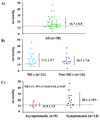Of founder populations, long QT syndrome, and destiny
- PMID: 19880070
- PMCID: PMC2802718
- DOI: 10.1016/j.hrthm.2009.08.036
Of founder populations, long QT syndrome, and destiny
Abstract
Founder populations, characterized by a single ancestor affected by long QT syndrome (LQTS) and by a large number of individuals and families who all are related to the ancestor and thereby carry the same disease-causing mutation, represent the ideal human model for studying the role of "modifier genes" in LQTS. This article reviews some of the fundamental concepts related to founder populations and provides the necessary historical background to understand why so many can be found in South Africa. The focus then moves to a specific LQT1 founder population, carrier of the A341V mutation, that has been studied extensively during the last 10 years and has provided a significant amount of previously unforeseen information. These novel findings range from an unusually high clinical severity not explained by the electrophysiologic characteristics of the mutation, to the importance of tonic and reflex control of heart rate for risk stratification, to the identification of the first modifier genes for clinical severity of LQTS.
Figures










References
-
- Schwartz PJ. Idiopathic long QT syndrome: Progress and Questions. Am Heart J. 1985;109:399–411. - PubMed
-
- Wang Q, Shen J, Splawski I, et al. SCN5A mutations associated with an inherited cardiac arrhythmia, long QT syndrome. Cell. 1995;80:805–811. - PubMed
-
- Curran ME, Splawski I, Timothy KW, Vincent GM, Green ED, Keating MT. A molecular basis for cardiac arrhythmia: HERG mutations cause long QT syndrome. Cell. 1995;80:795–803. - PubMed
-
- Wang Q, Curran ME, Splawski I, et al. Positional cloning of a novel potassium channel gene: KVLQT1 mutations cause cardiac arrhythmias. Nat Genet. 1996;12:17–23. - PubMed
-
- Schwartz PJ, Priori SG, Napolitano C. The long QT syndrome. In: Zipes DP, Jalife J, editors. CARDIAC ELECTROPHYSIOLOGY. FROM CELL TO BEDSIDE. III EDITION. Philadelphia: WB Saunders Co; 2000. pp. 597–615.
Publication types
MeSH terms
Substances
Grants and funding
LinkOut - more resources
Full Text Sources

